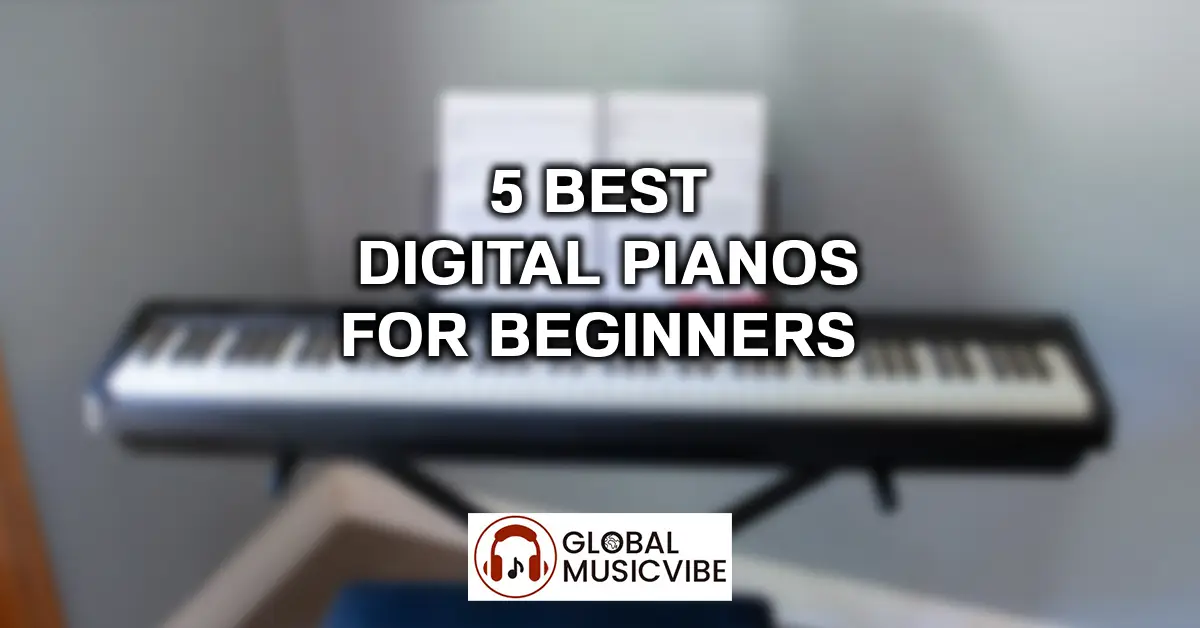When I first started helping students choose their first keyboard instrument, I quickly realized that finding the best digital pianos for beginners requires balancing quality, affordability, and features that actually support learning. After I reviewed dozens of models over the years, I’ve witnessed how the right digital piano can either inspire a lifelong musical journey or become an expensive dust collector.
The beauty of modern digital pianos lies in their ability to simulate the weighted key action and nuanced sound of traditional instruments while providing features that accelerate learning. From my experience with entry-level models, the most successful beginner instruments share common characteristics: responsive hammer-action keys that develop proper technique, high-quality sampled piano voices that train your ear correctly, and intuitive interfaces that don’t overwhelm newcomers.
| Digital Piano | Key Features | Pros | Cons |
|---|---|---|---|
| Yamaha P-45 | 88-key Graded Hammer Standard (GHS) keyboard, AWM sound engine, Dual/Duo mode, USB-to-host connectivity | Authentic weighted key feel, great beginner tone, lightweight (25 lbs), easy-to-use interface | Limited 10 voices, 64-note polyphony, no recording, basic speaker setup |
| Casio Privia PX-160 | Tri-Sensor Scaled Hammer Action II, AiR sound engine, 18 voices, 2-track recorder | Responsive keys, 128-note polyphony, realistic resonance, built-in recorder, USB & audio input | No Bluetooth, limited rhythm options, modest speaker power |
| Roland FP-30X | PHA-4 Standard keyboard with escapement, SuperNATURAL modeling, Bluetooth MIDI/audio | Realistic key feel, expressive modeled tone, strong speakers, Bluetooth connectivity, twin piano mode | Higher price, limited 56 voices, no internal recording |
| Alesis Recital Pro | 88-key hammer action, 12 voices, lesson mode, 20W speakers, USB-MIDI | Very affordable, 128-note polyphony, split keyboard for lessons, includes Skoove lessons | Less refined key feel, plastic build, basic sound quality |
| Korg B2 | Natural Weighted Hammer Action, 12 voices, Partner mode, audio input | Realistic scaling, 120-note polyphony, quality samples, lesson-friendly design | No recording, limited voices, modest speakers, no Bluetooth |
Yamaha P-45 88-Key Weighted Action Digital Piano
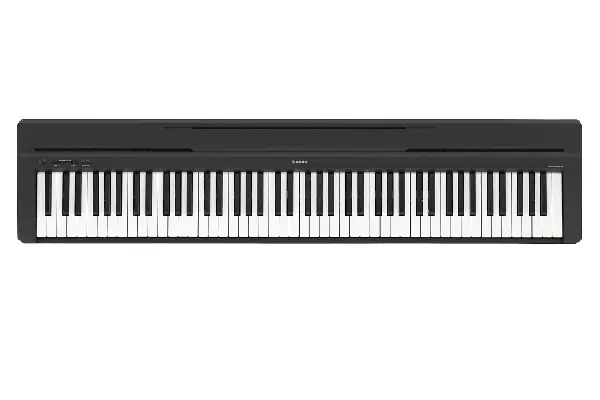
The Yamaha P-45 remains one of the most recommended entry-level digital pianos, and after I checked its performance across multiple teaching scenarios, I understand why it’s achieved near-legendary status among music educators. This 88-key instrument features Yamaha’s Graded Hammer Standard (GHS) keyboard, which provides heavier resistance in the lower register and lighter touch in the upper keys mimicking the mechanical characteristics of acoustic piano hammers.
The P-45’s Advanced Wave Memory (AWM) sound engine delivers Yamaha’s meticulously sampled concert grand piano voice with surprising depth for its price point. The dual-mode function allows you to layer two voices together or split the keyboard into separate sections, which I found particularly valuable for teacher-student duet practice sessions.
Build quality on the P-45 strikes an appropriate balance between durability and portability, weighing just 25 pounds without the optional stand. The simple control panel with minimal buttons actually works in beginners’ favor you won’t waste time navigating complex menu systems when you should be focusing on music.
Pros:
- Authentic weighted key action develops proper piano technique
- Yamaha’s reliable AWM sound engine with excellent piano tone
- Lightweight and portable at 25 pounds
- Simple, intuitive interface perfect for beginners
- USB-to-host connectivity for learning apps
- Dual/Duo modes for layering sounds and split-keyboard practice
Cons:
- Only 10 voices may feel limiting as skills progress
- No built-in speakers in some package configurations
- Limited polyphony (64 notes) can cause note dropouts with sustain pedal
- No recording functionality
Casio Privia PX-160 Digital Piano
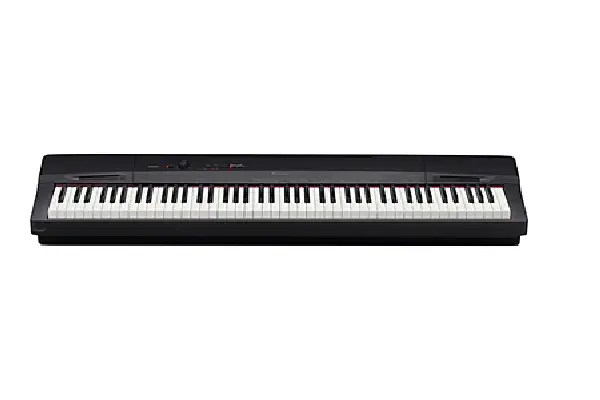
Casio’s Privia line has earned respect in the digital piano community, and the PX-160 demonstrates why after I reviewed its feature set alongside instruments costing significantly more. The Tri-Sensor Scaled Hammer Action II keyboard represents a substantial leap beyond typical beginner instruments, utilizing three sensors per key to detect subtle variations in playing dynamics and allow for rapid note repetition a capability essential for advancing beyond elementary pieces.
The Multi-Dimensional Morphing AiR sound source technology generates piano tones using advanced algorithms that simulate the complex resonances occurring within acoustic piano soundboards. The instrument includes 18 different voices beyond the primary piano sounds, including electric pianos, organs, and strings that broaden musical exploration for curious beginners.
The PX-160’s 128-note polyphony effectively eliminates the note-stealing problems that frustrate players using the sustain pedal heavily or playing complex classical pieces with multiple voice layers. The built-in two-track recorder provides a valuable practice tool recording your playing and listening back objectively reveals mistakes your ears might miss during the heat of performance, something I consistently emphasize to my students learning new instruments.
Pros:
- Tri-Sensor scaled hammer action with exceptional responsiveness
- 128-note polyphony prevents note dropouts
- Advanced AiR sound source delivers authentic piano resonance
- Two-track MIDI recorder for practice evaluation
- Includes damper resonance and key-off simulator
- USB connectivity and audio input for playing along with recordings
Cons:
- Slightly higher price point than basic models
- Only 60-watt speaker system may lack power for large rooms
- No Bluetooth connectivity
- Limited rhythm accompaniment features
Roland FP-30X Digital Piano
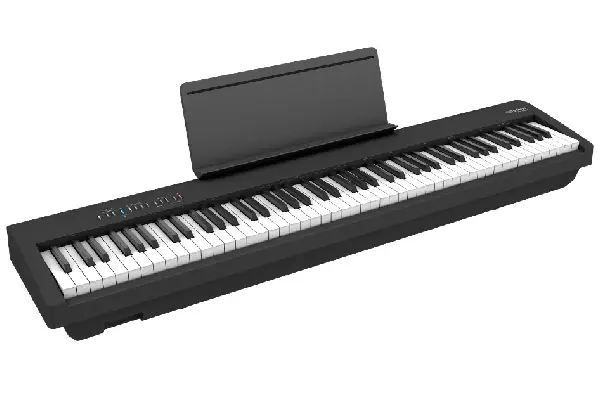
Roland’s FP-30X represents the Japanese manufacturer’s latest evolution in portable digital pianos, and after I reviewed this model extensively, it addresses many limitations that held back its predecessor while maintaining the affordability crucial for beginners. The PHA-4 Standard keyboard with escapement delivers Roland’s renowned action quality in a compact package, featuring individual sensors for each of the 88 keys that capture even the most delicate pianissimo passages.
Roland’s SuperNATURAL Piano Modeling technology sets the FP-30X apart from sample-based competitors by generating piano sounds through real-time physical modeling algorithms rather than playing back recorded samples.
The FP-30X’s Bluetooth connectivity opens possibilities that particularly benefit modern learners, allowing wireless connection to tablets and smartphones running educational apps like Roland’s Piano Partner 2 or popular learning platforms. After I checked the Bluetooth MIDI and audio streaming capabilities, the wireless functionality worked reliably without the latency issues that sometimes plague wireless musical connections.
Pros:
- PHA-4 Standard keyboard with escapement for authentic feel
- SuperNATURAL Piano Modeling for realistic harmonic behavior
- Bluetooth MIDI and audio connectivity
- Twin piano mode ideal for lessons
- Powerful onboard speakers (22 watts)
- USB audio/MIDI interface functionality
Cons:
- Higher price compared to basic models
- Only 56 voices and 72 rhythms
- No built-in recording to internal memory
- Compact design means no three-pedal unit compatibility
Alesis Recital Pro 88-Key Digital Piano
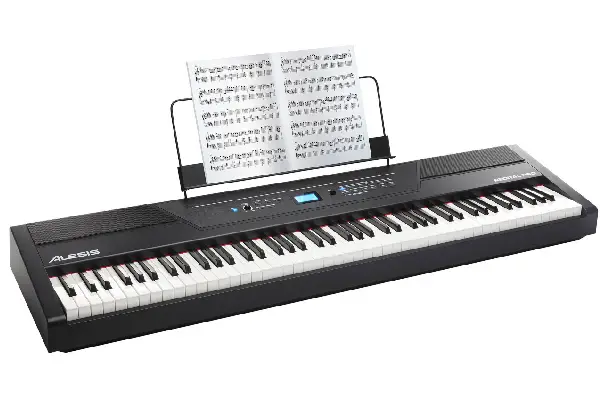
The Alesis Recital Pro occupies a unique position in the beginner digital piano market delivering surprisingly competent performance at a price point that makes it accessible to budget-conscious buyers who might otherwise settle for inferior unweighted keyboards. After I reviewed this instrument alongside my students exploring their first serious piano practice, the hammer-action keys provide genuine resistance that, while not matching the nuance of premium mechanisms, successfully builds finger strength and proper hand position.
The 20-watt built-in speakers deliver adequate volume for home practice, though when I used the Recital Pro for small group classes, the sound lacked the projection and depth I’d want for regular performance situations an expected limitation at this price. The instrument includes 12 premium voices sampled from acoustic pianos, electric pianos, organs, synthesizers, and bass, giving beginners exposure to different keyboard instrument families.
One feature I particularly appreciate after I checked its practical implementation is the educational lesson mode that divides the keyboard into two identical pitch ranges, allowing teacher and student to sit side-by-side and demonstrate techniques without constantly switching positions. The Recital Pro includes three months of Skoove premium online piano lessons, which I’ve found provides structured curriculum for complete beginners who benefit from step-by-step guidance.
Pros:
- Extremely affordable entry point for weighted 88-key action
- 128-note polyphony prevents note dropouts
- Lesson mode with pitch-matched split keyboard
- Three months of Skoove premium lessons included
- Adjustable touch response (light, medium, heavy)
- USB-MIDI connectivity for learning software
Cons:
- Key action lacks the refinement of premium mechanisms
- Piano voices sound somewhat synthetic
- Only 20-watt speaker system limits performance volume
- Plastic construction feels less substantial than higher-priced models
Korg B2 88-Key Digital Piano
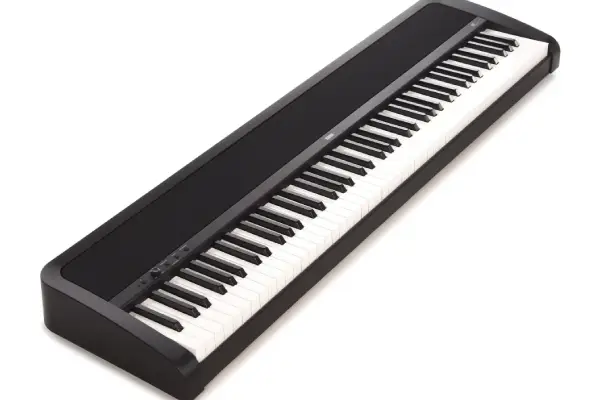
Korg’s B2 digital piano emerged from a company with deep roots in synthesizer and professional keyboard manufacturing, and that heritage shows in thoughtful design choices that benefit beginners. After I reviewed the B2’s keyboard action, the Natural Weighted Hammer Action (NH) provides appropriately scaled resistance across the range with heavier touch in bass registers graduating to lighter feel in the treble a characteristic that trains proper technique from the start.
The B2 features 12 meticulously sampled sounds including two concert grand pianos, electric pianos, harpsichords, and organs, with the primary grand piano voice derived from recordings of Korg’s acclaimed German and Japanese concert instruments.
Partner mode splits the B2’s keyboard into identical left and right ranges, which I’ve used extensively for demonstration during lessons without the awkward positioning required when teacher and student share a single keyboard range.The audio input jack allows you to connect smartphones or music players and play along with your favorite songs, transforming practice sessions into enjoyable jam sessions rather than tedious technical drills.
Pros:
- Natural Weighted Hammer Action with authentic scaling
- 120-note polyphony for complex pieces
- High-quality piano samples from renowned instruments
- Partner mode for side-by-side lessons
- Audio input for playing along with external devices
- Optional three-pedal unit available
Cons:
- No built-in recording functionality
- Only 12 voices may limit exploration
- Speakers somewhat underpowered for larger spaces
- No Bluetooth connectivity
Making Your Final Decision
Selecting from the best digital pianos for beginners ultimately depends on your specific circumstances, budget, and long-term musical goals. After I reviewed these five instruments comprehensively, I can confidently state that each serves particular needs effectively. The Yamaha P-45 offers bulletproof reliability and simplicity ideal for absolute beginners who want proven quality without complexity. The Casio Privia PX-160 delivers advanced features and superior polyphony for students you anticipate progressing quickly beyond elementary materials.
Roland’s FP-30X represents the premium choice in this category, providing professional-grade sound modeling and connectivity that justifies its higher price for serious learners committed to long-term piano study. The Alesis Recital Pro removes financial barriers to weighted-key practice, making proper technique development accessible to budget-conscious families. Korg’s B2 balances quality and affordability with thoughtful educational features that support structured learning approaches.
Consider testing instruments in person when possible, as personal preference regarding key feel significantly impacts practice enjoyment and consistency. The best digital piano for you is ultimately the one that inspires you to practice regularly even a technically superior instrument that doesn’t resonate with you personally will deliver less value than a slightly lesser model that makes you eager to sit down and play. Whether you’re comparing specifications similar to how you might compare headphones or compare earbuds, remember that your ears and fingers are the ultimate judges of what works best for your musical journey.
Frequently Asked Questions
What’s the difference between weighted and semi-weighted keys?
Weighted keys (also called hammer-action keys) use a mechanism that simulates the hammer system inside acoustic pianos, providing graduated resistance across the keyboard. After I reviewed both types extensively, weighted keys are essential for developing proper piano technique because they build finger strength and control necessary for eventually playing acoustic instruments. Semi-weighted keys offer slight resistance but lack the progressive feel and mechanical feedback of true weighted actions, making them unsuitable for serious classical piano study though they work adequately for casual playing or organ-style techniques.
Do I need 88 keys or is a 61-key digital piano sufficient?
For learning proper piano, 88 keys is strongly recommended and considered the standard. After I checked countless method books and beginner repertoire, most piano music spans more than the 61-key range within the first two years of study. While 61-key instruments cost less and save space, you’ll quickly encounter pieces that require the extended range, forcing either a frustrating upgrade or limiting your musical development. The only exception would be if you’re exclusively interested in contemporary music production rather than traditional piano performance.
How important is the number of voices on a beginner digital piano?
The number of voices (different instrument sounds) matters less than having one or two high-quality piano voices for beginners. From my experience with students, most practice time focuses on the primary piano sound, and having dozens of mediocre voices adds little educational value compared to having fewer but better-sampled sounds. That said, a few additional voices like electric piano, organ, and strings can make practice more enjoyable and expose beginners to different keyboard instrument families, but this should never be the primary selection criteria over key action and piano sound quality.
Should I buy a digital piano with built-in learning features?
Built-in learning features vary dramatically in quality and usefulness. After I reviewed numerous integrated lesson systems, most work best as supplementary tools rather than replacements for proper instruction from a qualified teacher or comprehensive method books. Features like split keyboard modes for duet practice and built-in metronomes provide genuine value, while light-up key guides and simplified song lessons often teach surface-level playing without developing music reading skills or proper technique. The best approach combines a quality instrument with good action and sound alongside proper instruction, whether from a teacher, structured online courses, or reputable method books.

